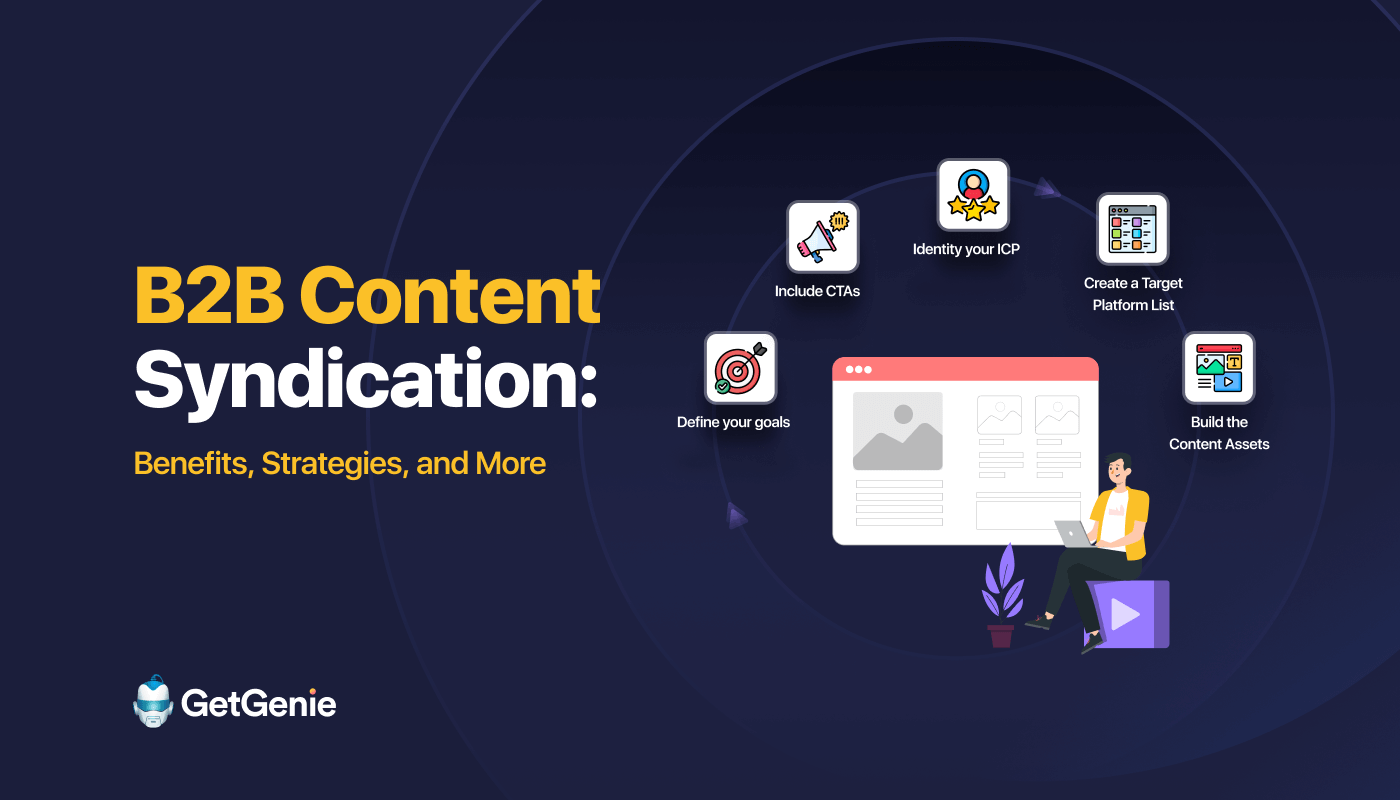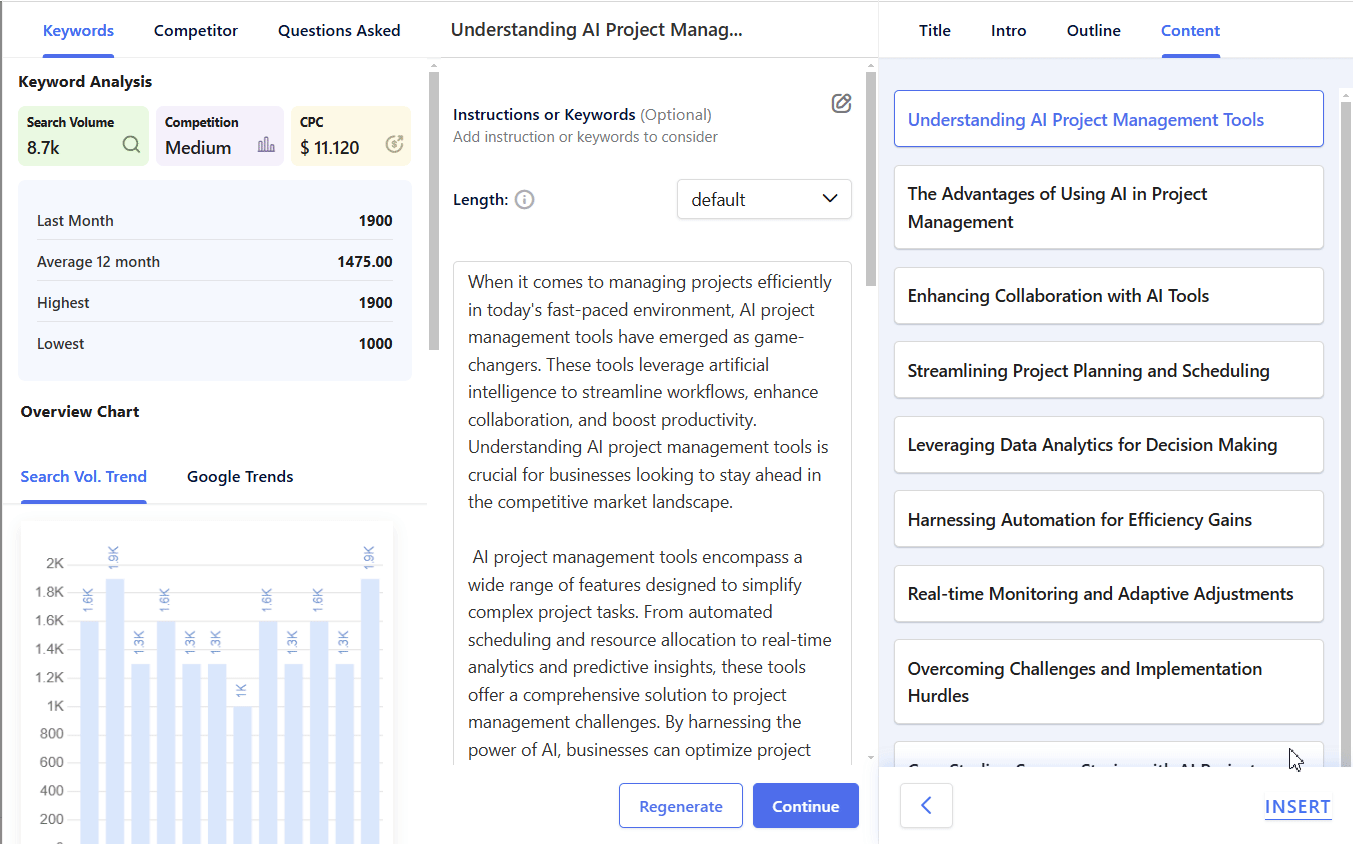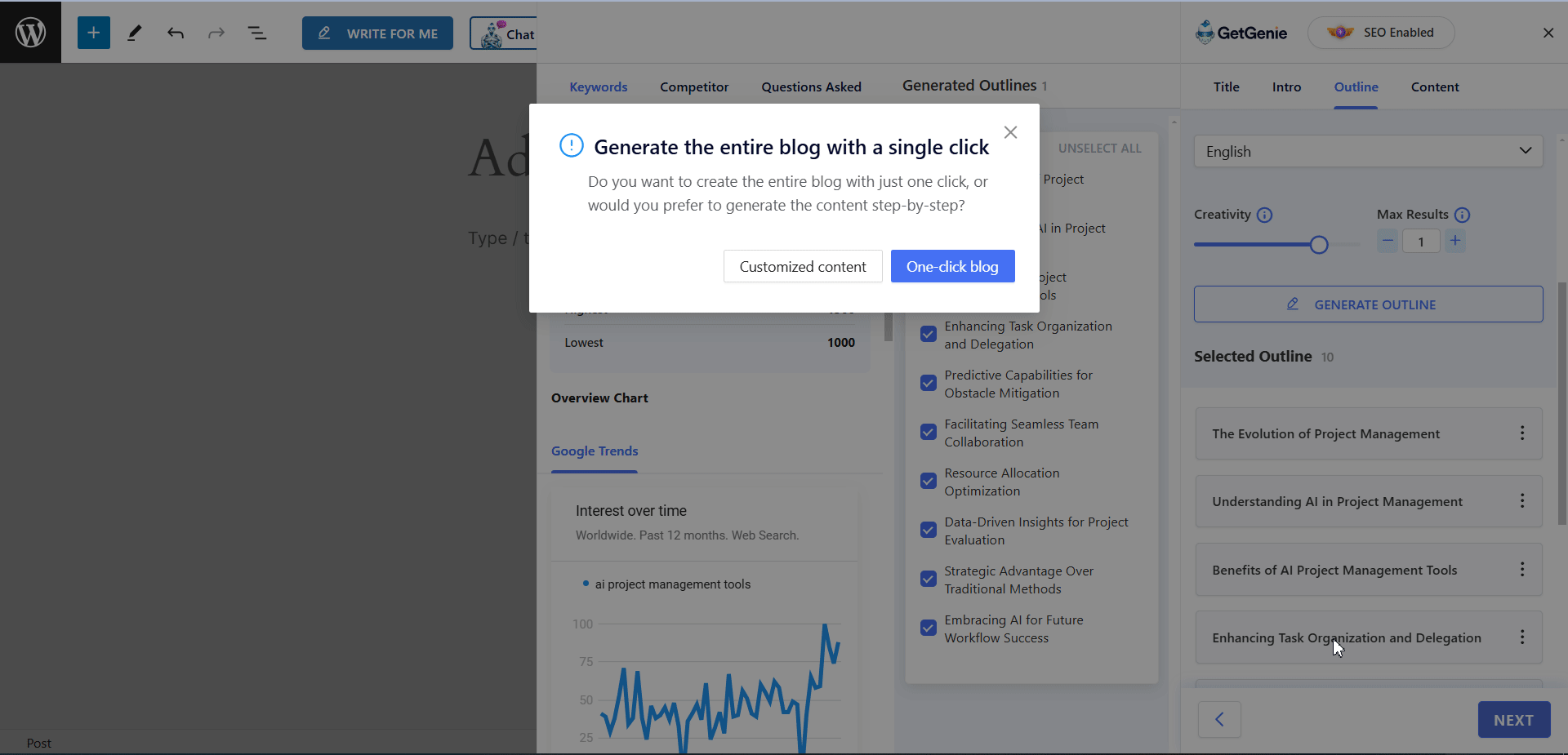B2B Content Syndication: Benefits, Strategies, & More

In B2B marketing, creating valuable content is time-intensive, but the real struggle lies in getting that content in front of the right audience quickly. Traditional content distribution often involves creating and repurposing new assets, which can slow down the process and delay results.
This is where B2B content syndication shines as it speeds up the content distribution process by letting you utilize existing content & instantly distribute it across multiple platforms. Without the need to create new assets from scratch, you can amplify your reach, engage more prospects, and generate leads faster.
In this write-up, I will explore the content syndication strategies, benefits, and other key factors that make it a must-have in your B2B marketing strategy.
- Understanding Content Syndication
- Republishing Same Content on Multiple Platforms — Isn't it Plagiarism?
- B2B Content Syndication – Perks & Benefits
- Content Types to Leverage for Syndication
- How to Nail B2B Content Syndication & Generate More Leads
- Create High-Quality, Targeted Content
- Leverage Trusted Third-Party Platforms
- Include Lead Capture Elements in Syndicated Content
- Tailor Content to Each Syndication Channel
- Segment and Personalize Content for Different Audiences
- Track and Measure Performance
- Repurpose and Repackage Content
- Integrate Social Media with Content Syndication
- Use Paid Media to Boost Syndicated Content
- Optimize for SEO with Backlinks
- Maintain a Consistent Syndication Schedule
- Nurture and Follow Up with Leads
- Content Syndication Platform Types with Examples
- Paid vs. Free Content Syndication
- Tap into Content Syndication to Get the Most out of It
Understanding Content Syndication
Content syndication is the process of republishing content—such as blog posts, articles, videos, or podcasts—on third-party websites or platforms to reach a wider audience and increase visibility.
It allows content creators to extend the reach of their content beyond their own site, tapping into new audiences and gaining more traffic without creating new material each time.
Let’s say you run a tech blog that writes about the latest developments in artificial intelligence. You published a well-researched article called “The Future of AI: 5 Trends to Watch in 2025.”
Instead of only publishing the article on your blog, you use content syndication to republish the article on TechCrunch, Médio, and other tech-focused sites. You also share it with AI-related forums and news aggregators like Reddit ou Flipboard.
Republishing Same Content on Multiple Platforms — Isn’t it Plagiarism?
Content syndication does not typically fall under plagiarism as long as it is done properly and with the appropriate permissions.
Plágio occurs when someone takes someone else’s work and claims it as their own without proper attribution. This is illegal and unethical.
Content Syndication, on the other hand, is when you allow your content to be republished by others (with your permission) or when you republish your own content on other platforms. When done correctly, it involves clear attribution to the original source and is generally allowed under the terms of syndication agreements.
Include Clear Attribution
When your content is republished on other platforms, always ensure that your nome e a original source (your website or blog) are prominently featured. This gives credit to you as the original author and avoids any confusion about ownership.
Use Canonical Tags
One of the most important tools to prevent duplicate content issues (and the risk of being penalized by search engines for plagiarism) is the canonical tag.
O canonical tag tells search engines that a piece of content (like a blog post) has been syndicated and that your original article is the “primary” or “authoritative” source. This prevents the search engine from considering the syndicated version as duplicate content and harming your SEO.
Be Transparent with Syndication Agreements
If you’re syndicating your content to third-party platforms (like TechCrunch ou HuffPost), make sure you have a clear agreement or understanding with the platform about how the content will be attributed and linked back to your original article.
Avoid Republishing Entirely Without Changes
Google and other search engines prefer original content. If you’re republishing the same content on multiple sites without any changes or updates, it might be viewed as “duplicate content,” even if you’ve used canonical tags. To avoid this, consider:
- Republishing only part of the content (with a link back to the full post).
- Adding a unique intro or conclusion to the syndicated content that differentiates it from the original.
- Curating or summarizing your content differently on various platforms.
B2B Content Syndication – Perks & Benefits
- Increase content visibility & reach a wider, often more relevant, audience beyond your own website
- Enhance your brand’s credibility & recognition by getting your content published on authoritative websites and platforms
- Your syndicated content will likely include links to your original content or website. Get referral traffic through these links to your website, where visitors can convert into leads through forms, CTAs, or other lead magnets. This will fuel your lead-generation efforts.
- Also, improve your search engine rankings by getting backlinks from authoritative sites. This will contribute to improving your site’s search engine rankings.
- Syndicating content across multiple platforms lets you leverage it without incurring additional production costs.
- Reach your target audience multiple times quicker through visibility in high-traffic-generating sites & platforms
Content Types to Leverage for Syndication
- Postagens no blog – Example: Industry insights, how-to guides, or thought leadership articles.
- Whitepapers – In-depth reports offering valuable data or solutions to industry problems.
- Case Studies – Real-world examples demonstrating the effectiveness of your products or services.
- Infographics – Visually engaging content summarizing data or concepts for quick consumption.
- Webinars – Recorded or live presentations offering educational content to your audience.
- E-books – Longer-form content providing comprehensive information on a specific topic.
- Videos – Tutorials, product demos, or interviews to visually engage audiences.
- Podcasts – Audio content that can be repurposed from interviews, panel discussions, or industry news.
- News Articles – Timely and relevant content, often syndicated by press release services.
- Product Reviews & Testimonials – Feedback from customers or industry experts highlighting your product or service.
How to Nail B2B Content Syndication & Generate More Leads
Only creating content and distributing content to different platforms isn’t all about B2B content syndication. You have to follow proven steps to get the most out of B2B content syndication.
Create High-Quality, Targeted Content
The key to successful content syndication is creating content that addresses the specific challenges and needs of your target audience. High-quality, informative content establishes trust and credibility, encouraging engagement. Whether it’s a research report or a whitepaper, it should offer value and actionable insights.
Tailoring the content to your audience’s pain points increases the likelihood that it will resonate. This positions your brand as an authority in the field, helping you attract more qualified leads. The more relevant your content, the more it will capture attention and foster engagement.
With GetGenie, you can create various types of top-grade, personalized content, including blog posts, articles, case studies, and product reviews with AI magic.
For example, if you want to create a blog post, you can do it following a minimal workflow. Based on your given keyword and a little context, GetGenie will help you generate step-by-step, well-optimized content in minutes.

Alternatively, the AI writing tool can also generate structured content for you in a snap with its step-less one-click blog generator capability.

Once you get the content on your screen, you can rewrite a section of the content, add more points, and also optimize the content with NLP-based keyword suggestions, head-to-head analysis with competitors, and more.

Leverage Trusted Third-Party Platforms
Syndicating content on trusted, high-traffic platforms boosts your content’s reach and credibility. These platforms already have an established audience, allowing you to tap into new pools of potential leads. Industry-specific blogs, publications, and trade sites are excellent places to start.
Choosing platforms with high domain authority ensures your content is seen by decision-makers. Sites like TechCrunch or industry blogs have credibility, making your content more likely to be shared and trusted. The goal is to build brand awareness in environments where your audience is already engaged.
Include Lead Capture Elements in Syndicated Content
Including clear calls-to-action (CTAs) in syndicated content is essential for lead capture. CTAs should direct readers to landing pages where they can exchange their contact info for valuable resources. This makes it easy for visitors to convert into leads.
Make sure your landing pages align with the syndicated content to create a seamless user experience. For example, offering a free consultation or a downloadable resource on your landing page makes it easy for potential leads to engage further. This increases the chances of capturing high-quality leads.
Tailor Content to Each Syndication Channel
Different syndication platforms have varying audience preferences and content formats. Tailor your content to fit the style and expectations of each platform for better engagement. Long-form articles might work well on blogs, while shorter, visual content may perform better on social media.
By adapting your content for each channel, you ensure maximum relevance and impact. This approach increases the likelihood that your content will resonate with the audience, generating more traffic and leads. Repurposing content for different formats helps extend its reach across platforms.
Segment and Personalize Content for Different Audiences
Personalizing content for specific buyer personas increases its relevance and effectiveness. Segment your audience based on roles, industries, or needs, and tailor content accordingly. For example, content for HR managers should differ from content aimed at IT directors.
Segmented and personalized content speaks directly to the pain points of each audience group. This targeted approach ensures higher engagement and better lead quality, as it addresses the specific concerns of different decision-makers within your target market.
Track and Measure Performance
Tracking and analyzing the performance of your syndicated content is crucial for optimizing future efforts. Use analytics to monitor key metrics such as click-through rates, lead conversions, and bounce rates. This data provides insights into what’s working and what needs improvement.
By measuring performance, you can refine your content strategy over time. This ensures that you focus on the most effective content formats and platforms, allowing you to maximize lead generation and ROI. Continuous tracking helps you stay aligned with your audience’s needs.
Repurpose and Repackage Content
Repurposing and reformatting existing content helps extend its life and reach. Turn a blog post into an infographic, a webinar into a series of posts, or a whitepaper into a case study. This strategy saves time while reaching different audience segments through various formats.
Repackaging content for different channels ensures that it reaches the widest possible audience. By adapting content to fit various platforms, you increase engagement and visibility, driving more traffic back to your website for lead capture.
Integrate Social Media with Content Syndication
Promoting syndicated content on social media amplifies its reach and engagement. Share content across platforms like LinkedIn, Twitter, and Facebook to drive traffic back to your landing pages. Social media engagement can increase visibility and create more opportunities for lead generation.
Using social media also allows for direct interaction with decision-makers, further expanding your reach. By leveraging organic and paid promotion, you ensure that your syndicated content reaches a broader, more targeted audience, generating more high-quality leads.
Use Paid Media to Boost Syndicated Content
Paid promotion can significantly enhance the effectiveness of your syndicated content. Platforms like LinkedIn Ads or Google Ads allow you to target decision-makers with precision. Paid campaigns ensure that your content reaches the right people, increasing the likelihood of lead generation.
Paid media amplifies your content’s reach beyond organic efforts. By targeting specific industries, job titles, or company sizes, you can drive highly relevant traffic to your content, increasing both engagement and conversions.
Optimize for SEO with Backlinks
Syndicating content on authoritative platforms provides valuable backlinks that improve your site’s SEO. Backlinks signal to search engines that your content is credible, boosting your rankings and organic traffic. This is a long-term strategy to improve visibility and attract qualified leads.
Including backlinks within your syndicated content drives traffic back to your website. These links help enhance your domain authority over time, making it easier to rank for relevant search terms and generate consistent, organic traffic.
Maintain a Consistent Syndication Schedule
Consistency is key when it comes to content syndication. Regularly publishing and syndicating content helps maintain visibility with your target audience. By creating a steady stream of valuable content, you can build a reliable presence on relevant platforms.
A consistent syndication schedule keeps your brand top of mind among prospects. It builds trust and ensures that your content continues to drive traffic and generate leads over time, helping to establish your brand as an industry leader.
Nurture and Follow Up with Leads
Lead nurturing is essential to turning syndicated content into actual sales. After capturing leads, follow up with personalized emails, relevant content, and tailored offers. Marketing automation can streamline this process by sending targeted messages based on lead behavior.
By nurturing leads, you guide them through the sales funnel. Providing valuable content at each stage of their journey helps move prospects closer to a purchase decision, increasing the likelihood of conversion from syndicated content.
Content Syndication Platform Types with Examples
Encontrar third-party platforms where your target audience is likely to engage. These could include:
- Industry-Specific Websites – Example: TechCrunch
- B2B Publishing Networks – Example: Forbes
- Content Aggregators – Example: Outbrain
- Social Media Platforms – Example: LinkedIn
- Content Distribution Networks – Example: Taboola
- Online Communities and Forums – Example: Reddit
- Video Platforms – Example: YouTube
- Trade Publications – Example: MarketingProfs
- Email Newsletter Networks – Example: Curata
- Press Release Distribution Services – Example: PR Newswire
- Content Syndication Services – Example: Zemanta
- Content Sharing Platforms – Example: Médio
Paid vs. Free Content Syndication
Paid Content Syndication
Prós:
- Paid syndication allows for precise targeting to reach decision-makers.
- Your content is guaranteed prime visibility across top platforms.
- Targeted campaigns lead to more relevant engagement from your audience.
- Results are fast, with content reaching your audience almost instantly.
- You can easily scale your paid campaigns based on performance and budget.
Contras:
- Paid syndication can be expensive, especially for competitive industries.
- Once the budget is spent, your content’s visibility stops.
- Over time, your audience may ignore sponsored content, leading to reduced effectiveness.
Free Content Syndication
Prós:
- Free syndication allows exposure without any financial investment.
- Valuable content is shared naturally, expanding your reach organically.
- Content remains accessible, generating ongoing traffic and leads.
- Backlinks from syndication sites can improve your SEO and rankings.
- Being featured on authoritative sites boosts your brand’s credibility.
Contras:
- You have little control over how and where your content appears.
- Organic reach takes longer to generate traffic and leads.
- Free content often receives less attention than paid content on platforms.
- Without paid promotion, free syndication may lead to lower engagement.
- Changes to platform rules can negatively affect your content’s visibility.
Tap into Content Syndication to Get the Most out of It
B2B content syndication isn’t just a shortcut; it’s a strategic approach that can power up your marketing efforts.
If you’re looking to stay ahead in a competitive market and speed up your content’s journey to the right audience, syndication is the tool you need. With the right method, it can act as the difference between getting lost in the noise and standing out as a leader in your industry.

